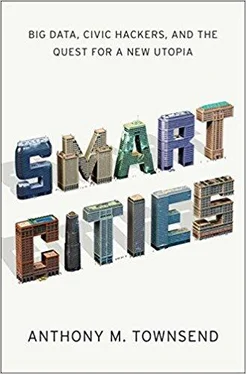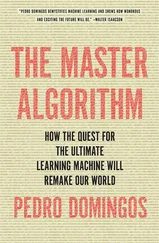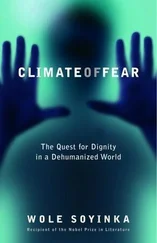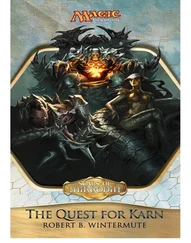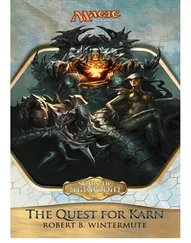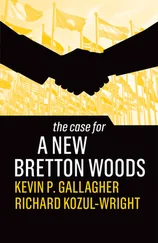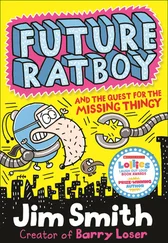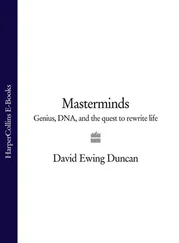Still, data-driven management for cities is an irresistible fiscal force shaping the future. Ironically, this has been proven most starkly in Baltimore, the setting of The Wire , the critically acclaimed television series that lambasted the destructive and corrupting influence of CompStat-style management. Applying CompStat techniques to other aspects of government like trash collection and pothole repairs saved the city at least $100 million during Mayor Martin O’Malley’s first term in office.36 One former official puts the savings as high as a half-billion dollars for his entire administration, which ended in 2007.3/ Not bad for a system that cost just $20,000 to set up and $350,000 a year to run.38
Tolva’s vision has a convincing air of inevitability. When I asked him to speculate on what big data means for cities in the future, his response was quick and terse. “Governing and policy making based on what the vital signs are telling us, not anecdote,” he said.39 Perhaps not surprisingly, his partner in reinventing Chicago’s government as a data-driven enterprise is himself a crime mapper. The country’s first municipal chief data officer, Brett Goldstein was brought over from the Chicago Police Department where, Tolva says, “he was crunching huge amounts of past crime data to nightly redeploy squads based on probability curves of incidents.” But in his new role Goldstein can look beyond just police reports, at the many other socioeconomic indicators that can help suss out the conditions that foster crime.
Tolva believes it will take a culture change in city government to realize the full potential of bigger data and deeper analytics. “If you have a department that does it, you are probably doing it wrong and it is not suffused throughout. Success would be not needing a champion of data-driven decision making in the mayor’s office,” he says.40 But it will take still more than culture change to use big data wisely. As it comes to inform more and more policy decisions, city leaders will have to become more sophisticated in how they evaluate data, whose indications are far more subtle than even the simple statistics they have relied on for many years. As Joe Flood found in his study of John Lindsays administration in New York City in the 1960s, mayors often champion new data tools and methods without really understanding them. “I remember that I once wrote a speech for Lindsay and he made me use the phrase ‘new budget science three times in it,” one budget aide told Flood, “and I’m convinced he didn’t know what the words actually meant.”41
“All Politics Is Local”
As we’ve seen, most cities that have sponsored apps contests skip over the most important step in design—identifying users’ needs. In-house number crunchers like Tolva largely serve the needs of their peers, using technology to improve the effectiveness of government agencies. But as Tip O’Neill, the lion of Massachusetts politics, famously said, “All politics is local.” Not surprisingly, in O’Neill’s hometown of Boston, Mayor Tom Menino began building a smart city by using technology to hack new solutions to address the everyday problems of citizens. In 2010, he created a task force to rapidly prototype new civic technology, the Office of New Urban Mechanics.
Menino had a head start putting citizens first. If you want to start building a smart city by tackling problems rather than exploring what you can build with new tools, it certainly helps to have been in office for two decades. Over his long tenure, the mayor had built up a political nervous system that spanned the metropolis, pumping community concerns into his staff’s BlackBerrys minute by minute. But Menino was on the beat himself—as he announced in early 2013 his plans to finally retire, a Boston Globe poll reaffirmed a widely known statistic: the mayor had personally met more than half of his constituents 42 He didn’t have to mine massive databases or launch apps contests to find new problems; his To-Do list was already a mile long. And with a deep understanding of where the gaps in the system lay, one could fine-tune instead of overhauling.
The Office of New Urban Mechanics’ name conjures images of overall-clad technicians spelunking into grease-filled gearboxes deep under the Brutalist architectural abomination that serves as Boston City Hall.43 But as Nigel Jacob, the group’s cochair explained, it was a reference to Menino’s own early life as data junkie. In the late 1980s, “He was a city councilman, and his vision of the city was focused on livability. He was entirely focused on classic quality of life indicators.” This pragmatic focus on street-level performance led the Boston Globe Magazine to dub him in 1994, “the urban mechanic.”44 Unlike cities where the mayor’s tech stars were busy launching apps contests, publishing open data, or running analytics, in Boston the mayor focused them on building tools for citizen engagement. “Technology is not part of our mission,” explained Chris Osgood, a veteran civil servant who previously worked for New York City’s Department of Parks and Recreation and who, as Jacob’s cochair, made up the other half of the Office of New Urban Mechanics. “It is to connect people and government better.”
Consider Boston’s approach to the snow problem, as compared to Chicago or New York. Just as those cities were opening up their snowplow maps in January 2012, New Urban Mechanics launched “Adopt-A-Hydrant,” a Web app that allowed neighborhood volunteers to claim local fireplugs as their own winter wards. On top of responding to over five thousand fires each year, the Boston Fire Department is responsible for shoveling out over thirteen thousand hydrants after every major snowstorm. In future snowstorms, Adopt-A-Hydrant will send text and e-mail alerts to let people know when and how to properly remove the snow from the fire hydrant they’ve “adopted.”4 It’s an interesting, lean model, a low-tech approach that relies on citizens’ own labor and the existing cellular network. It signalled that the city was doing something about snow without the need to spend lots of money. But was it practical? Scanning the site in summer 2012, six months after its January launch, I found fewer than a dozen hydrants claimed. I called up Jacob, who explained that the system hadn’t yet been truly tested due to a lack of snow the previous winter. “We were a victim of global warming,” he mused, “We never had a chance to use it.”46
Compared to most of the cities we’ve seen, New Urban Mechanics was founded on a fundamentally different philosophy about how technology can be used to transform local government. For Osgood, the big opportunity was undoing decades of inward-looking thinking in city government, which he felt was being amplified by data-driven management and writing citizens out of the loop. “We’ve become so focused on, how much faster can we fill that pothole? How much quicker can we remove that graffiti?” he asked, lambasting the approach embedded in programs like CompStat, “that we try to quickly optimize our own operation in a way that actually doesn’t engage constituents and make them part of the design process.” Osgood continued, “Think of how Wikipedia was built. Think about how Google gets stronger every time somebody does a search. They’ve made it very simple for people to get involved in the process and strengthen the product with their own participation.”47 The New Urban Mechanics team didn’t just preach crowdsourcing; it also relied on crowdsourcing to get its own work done. While the office didn’t have its own budget (it didn’t officially exist in a formal bureaucratic sense, to keep it “lightweight” and preserve “a start-up character we have gone to great lengths to maintain,” Jacob said), Jacob and Osgood and five program managers spread through various city departments formed a network funded by about $300,000 in city money and a slew of grants from local and national foundations. It was a sizeable workforce for technology innovation compared to peer cities, and the team leveraged it to the hilt. “We don’t try to do any of the work ourselves,” Jacob explained. “We try to find people that are doing work in the space already that have similar goals to us, that we can partner with and actually deliver on.” Instead of micromanaging, they stayed strategic. “We think about design, and we think about more classic policy questions.” Procurement rules put in place to fight corrupt contracting limited its ability to quickly purchase new technology. But they embraced the S 10,000 limit on what they could spend without a lengthy bidding process as a useful constraint that “forces us to think lean and mean,” Jacob said. And it speeds things up. “You’re talking about very small dollars. You’re talking about weeks versus months.”49 Above all, “Urban Mechanics is an experimental laboratory,” he told me.50
Читать дальше
